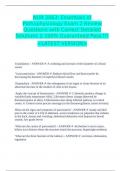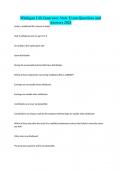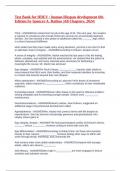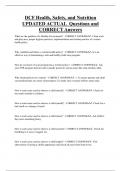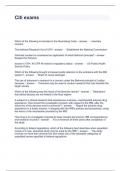NUR 2063: Essentials of
Pathophysiology Exam 2 Review
Questions with Correct Detailed
Solutions || 100% Guaranteed Pass !!!
<LATEST VERSION>
Vasodilation - ANSWER ✔ A widening and increase of the diameter of a blood
vessel.
Vasoconstriction - ANSWER ✔ Reduces blood flow and heat transfer by
decreasing the diameter of superficial blood vessels.
Hyperplasia - ANSWER ✔ the enlargement of an organ or tissue because of an
abnormal increase in the number of cells in the tissues.
Apply the concept of homeostasis - ANSWER ✔ 1.Stimulus produce change in
variable (body temperature falls), 2.Receptor detect change (detected by
thermoreceptors in skin), 3.Information sent along Afferent pathway to control
center, 4. Control centre process message (in the thermoregulatory centre in brain).
What are the signs and symptoms of pancreatitis? - ANSWER ✔ steady and dull
pain in the center or LUQ of abdomen, severe tenderness on palpation that radiates
to the back, nausea and vomiting, abdominal distention with hypoactive bowel
sounds, low grade fevers
What are the causes of pancreatitis? - ANSWER ✔ alcoholism is most causes,
biliary tract disease where the enzymes attack the pancreas, hypertriglyceridemia
What are the three function of the kidneys - ANSWER ✔ excretion, elimination,
regulation
, Explain what excretion is? - ANSWER ✔ removal of organic waste products from
body fluids
Explain what elimination is? - ANSWER ✔ discharge of the waste products from
the body
Explain what regulation is? - ANSWER ✔ regulating blood volume, ion
concentration, blood pH and nutrients
What are signs and symptoms indicating one may have a renal disorder? -
ANSWER ✔ pain in the back flank area that is felt at the CVA angle on
percussion, tenderness, abnormal urinalysis findings
What types of things are abnormal regarding urinalysis? - ANSWER ✔ dark,
strong smelling urine, bacteria in the urine, cloudy urine, ketones or glucose or
proteins in the urine, blood in the urine (except during menses)
What is polycystic kidney disease? - ANSWER ✔ an inherited condition of the
kidney resulting in one having fluid filled cysts on one or both kidneys. if left
untreated renal failure with need for dialysis or kidney transplant occurring
What causes polycystic kidney disease? - ANSWER ✔ it is inherited genetically
What are the types of polycystic kidney disease? - ANSWER ✔ autosomal
recessive and dominant
What is a nephron(s)? - ANSWER ✔ they are in the kidney and helps to filter
blood and remove waste products
How many nephrons do the kidneys have? - ANSWER ✔ 1-2 million
What is hematuria? - ANSWER ✔ blood found in the urine not due to
menstruation
What is proteinuria? - ANSWER ✔ protein found in the urine
What does it mean when one has ketones in their urine? - ANSWER ✔ they have
type 1 diabetes
, What is nephrolithiasis? - ANSWER ✔ kidney stones that obstruct the ureters and
kidneys that cause lots of pained urinary stasis
What is another term for kidney stones? - ANSWER ✔ renal calculi
What are kidney stones made up of? - ANSWER ✔ calcium deposits and uric acid
What is pyelonephritis? - ANSWER ✔ infected and inflamed kidneys
What causes pyelonephritis? - ANSWER ✔ e.coli from the lower urinary tract that
ascends
What are the signs and symptoms of pyelonephritis? - ANSWER ✔ CVA
tenderness most common, fever, chills, N/V, anorexia or not willing to eat
What can we do the prevent pyelonephritis? - ANSWER ✔ remove catheters are
early as possible to prevent UTIs and possible spread
What are the signs and symptoms of post infectious acute glomerulonephritis? -
ANSWER ✔ Smoky or coffee colored urine, proteinuria, edema as they cannot
urinate, decreased output
What is the cause of post infectious acute glomerulonephritis? - ANSWER ✔ type
b hemolytic strep; follows impetigo and strep throat
What age group is most affected by post infectious acute glomerulonephritis? -
ANSWER ✔ children in developing countries
What are the signs and symptoms of acute kidney injury? - ANSWER ✔ Sudden
reduction in kidney function, decreased urine output, although occasionally urine
output remains normal
Fluid retention, causing swelling in your legs, ankles or feet
Shortness of breath
Fatigue
Confusion
Nausea
Weakness
Irregular heartbeat
Chest pain or pressure
Seizures or coma in severe cases
, What are the 3 stages of causes of acute kidney injury - ANSWER ✔ pre renal,
intrarenal or intrinsic, post renal
Endoplasmic Reticulum - ANSWER ✔ an internal membrane system in which
components of cell membrane and some proteins are constructed. (Smooth &
Rough ER)
Function of hormone renin - ANSWER ✔ Renin is an enzyme that helps control
your blood pressure and maintain healthy levels of sodium and potassium in your
body. (When blood volume or sodium levels in the body are low, or blood
potassium is high, cells in the kidney release the enzyme, renin. Renin converts
angiotensinogen, which is produced in the liver, to the hormone angiotensin I.)
Hydrostatic pressure capillaries - ANSWER ✔ The pressure that blood exerts in
the capillaries is known as blood pressure. The force of hydrostatic pressure means
that as blood moves along the capillary, fluid moves out through its pores and into
the interstitial space.
Increased hydrostatic capillary action causes edema (T/F) - ANSWER ✔ (True)
Edema- Is swelling or excessive fluid.
include high venous pressure (e.g., heart failure, venous blockage) or excessive
fluid and sodium retention (e.g, acute renal failure).
What body functions cause fluid volume deficits? - ANSWER ✔ Blood loss from
cuts/wounds Through the gastrointestinal system: vomiting and diarrhea
Abnormally excessive urination (polyuria); can be caused by excessive intake of
diuretic substances or medications or from renal disorder.
Tetany - ANSWER ✔ a symptom characterized by the involuntary contraction of
muscles that leads to painful muscle cramps, spasms of the voice box (i.e., larynx),
and sensory disturbances.
What electrolyte is associated with muscular tetany? - ANSWER ✔ Hypocalcemia
- aka LOW calcium
tetany (muscle twitching/spasms)
Symptoms of dehydration - ANSWER ✔ thirst, headache, fatigue, loss of appetite,
dry eyes, dry mouth, dark-colored urine

